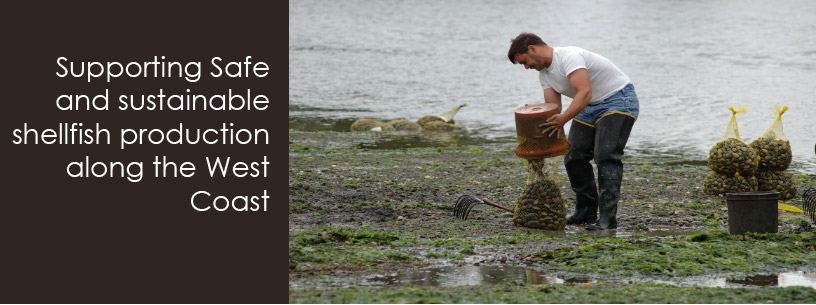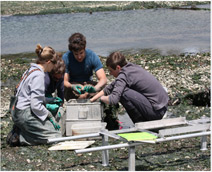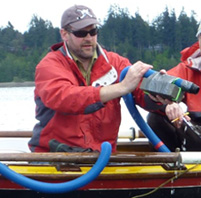PRODUCTION TECHNOLOGIES
Alternative Production Methods
Shellfish growers are a forward thinking group and look for the most effective ways to produce high quality shellfish. PSI has studied the efficiencies and possible impacts of alternative shellfish production methods for oysters, Manila clams, and geoduck. A majority of these methods increased beneficial interactions to the surrounding environment as compared to traditional farming techniques, including increased epibenthic and benthic production and refuge habitat. Yields increases were evident in many methods and in some cases, resulted in a superior product. In a few studies, the alternative method was proven to be ineffective in providing predator protection and was discontinued.
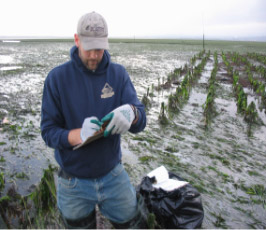
Geoduck clams, the largest burrowing clam in the world, have seen a rise in popularity throughout the world, which has led to increased farmed production in Washington and to a lesser extent, Alaska. While geoduck clams are native to the West Coast, farmed production of the species only became common place within the last few decades. As such, there is great interest in increasing our understanding of viable production technologies and potential environmental impacts of geoduck farming. PSI and collaborators have explored alternative production methods, environmental impacts, and wild stock interactions for geoduck in Washington. Alternative methods, such as use of biodegradable protective tubing for young geoduck, have proven effective in certain areas but more research is needed into how various techniques and technologies hold up in the long term.
Difficulties in consistently rearing geoduck larvae or seed is another research topic of interest to farmers in the Northwest. PSI staff are currently leading a study to examine the feasibility of triploid geoduck production. Triploidy is a genetic condition in which an organism has three sets of chromosomes rather than two. Common triploidy products include seedless watermelons, bananas, and oysters. Triploidy shellfish are reproductively sterile, which allows for improved growth rates and meat quality. Because the organisms are sterile, triploid shellfish are unable to breed with wild stocks. A stable supply of aquacultured triploid geoduck, therefore, would prevent cross-breeding and potential contamination of wild stocks. If the geoduck clams in our study display suitable yield and are consistently sterile, it may lead to the next generation of farmed geoduck.
FARM MANAGEMENT
Pest Management
PSI supports integrated pest management (IPM) for commercial shellfish aquaculture by helping growers identify appropriate environmentally and economically sound pest control methods and strategies. IPM is currently practiced in most major terrestrial crops, where the ecology of pests has been studied for over 75 years. In shellfish aquaculture practices, IPM methods are sometimes employed to control organisms that are harmful to shellfish operations such as burrowing shrimp or non-native species such as the oyster drill (snail) and Japanese eelgrass.
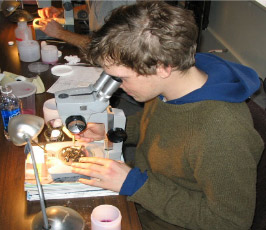
In 2008, PSI collaborated in the development of a 'Crop Profile for Bivalve Aquaculture in Washington State'. The Crop Profile includes a list of important pests and potential management tactics. This document was later expanded into the more comprehensive 'Pest Management Strategic Plan for Bivalve Aquaculture in Washington and Oregon'. More recently, PSI completed the 'Illustrated Field Guide to the Pests of Bivalve Aquaculture in Washington and Oregon' to address some of the complex management decisions facing bivalve producers in these states. Many of the organisms described in the guide may be pests at times to shellfish farmers, but at other times are integral members of the intertidal environment and perhaps important to both commercial producers and recreational users. Other organisms may be invasive species with the potential to severely disrupt intertidal ecology.
In 2021 PSI completed 'A Framework for the Integrated Management of Burrowing Shrimp in SW Washington' and associated Annotated Bibliography to assist Willapa Bay and Grays Harbor shellfish farmers and natural resource managers. The framework is an extension and update of related IPM Plans (Booth 2003, Booth 2007, and Booth 2010).
|
|
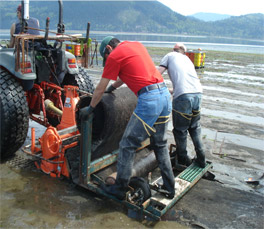
Mechanical harvester
Examining new methods of harvesting Manila clams.
|
|

Triploid geoduck seed
These seed, roughly the size of a human fingernail, will reach market size (1-2 lbs) in 4-7 years. |
|
|
|






